Apr 13, 2020
The best and worst trades in Blue Jays history
When you examine the Blue Jays' history of deals, there are many franchise-altering swaps that worked out well, and then there are some trades they really messed up, Scott Mitchell writes in the fourth of his nine-part series that looks at the best and worst in the franchise’s history.
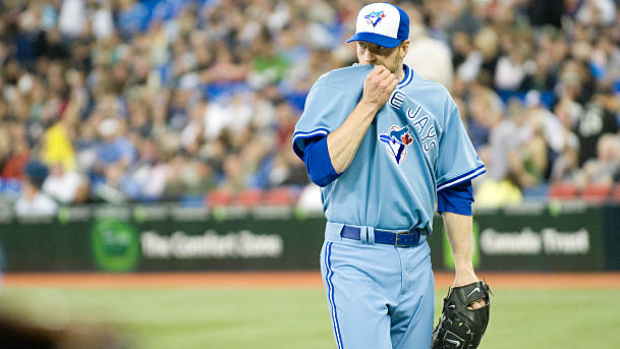
TORONTO — Trades have always been a huge part of baseball.
From blockbusters to bullpen moves to minor-league tinkering, swapping assets, big and small, is what general managers do.
There’s always a way to improve a roster, no matter where you sit in the standings.
When you examine the Toronto Blue Jays’ history of deals, the number of important, franchise-altering swaps that worked out well immediately jumps out.
On the flip side of that, when the time has come to tear down and rebuild, there’s a long history of messing up deals involving their most valuable trade chips.
For this one, I won’t bore you with a long preamble since there’s a lot to get to.
When research began for this list, I had nearly 20 trades on each side of the ledger, but these 12 deals stood out in the end.
The Best and Worst of the Blue Jays on TSN.ca:
Mon, April 6 – The five best and worst signings
Wed, April 8 – The five best and worst outfielders
Fri, April 10 – The five best and worst games
Mon, April 13 – The five best and worst trades
Wed, April 15 – The five best and worst infielders
Fri, April 17 – The five best and worst seasons
Mon, April 20 – The five best and worst draft picks
Wed, April 22 – The five best and worst pitchers
Fri, April 24 – The five best and worst moments
The Best Trades
5. (TIE) Daniel Norris, Matthew Boyd and Jairo Labourt to the Detroit Tigers for David Price, July 30, 2015; Junior Felix, Luis Sojo and Ken Rivers to the California Angels for Devon White, Willie Fraser and Marcus Moore, Dec. 2, 1990
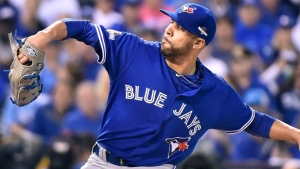 It felt like a lot to give up at the time, but GM Alex Anthopoulos knew how good his lineup was and how badly they needed a horse atop the rotation.
It felt like a lot to give up at the time, but GM Alex Anthopoulos knew how good his lineup was and how badly they needed a horse atop the rotation.
That is exactly what David Price became immediately, pitching brilliantly in a Jays uniform for two months down the stretch, finishing with a 9-1 record and a 2.30 ERA in 11 starts.
One game above .500 when the trade was made, the Jays went 41-18 the rest of the way to run away with the AL East.
Even though Price was pretty mediocre in the postseason and walked at the end of the season as a free agent, Anthopoulos hasn’t exactly lost a lot of sleep over what he gave up.
Boyd has developed into a quality starter at the age of 29, while Norris is still trying to find his way five years later.
Throughout this series, I’ve placed a huge importance on the return to the postseason in 2015 and what that meant to a franchise in desperate need of an adrenaline boost, which means grading the moves that got them back there a little bit differently.
Without the Price trade, even with a prolific offence, you can definitely argue the Jays’ playoff drought would’ve continued on.
Twenty-five years earlier, Jays GM Pat Gillick put his ski mask on and pulled off a heist that seems to have gone somewhat overlooked.
Three days prior to the blockbuster that also appears on this list, Gillick traded a couple of spare parts in Junior Felix and Luis Sojo to the West Coast in exchange for Devon White, who was coming off the worst year of his career, batting just .217 in 1990.
White immediately flipped the script on that decline in his first season with the Jays, quietly posting three straight seasons of across-the-board production and elite centre field defence.
From 1991-93, White was worth a total of 17.7 fWAR.
Most will be surprised to learn he was worth more than Roberto Alomar’s 16.1 fWAR during the same timeframe.
4. Brett Lawrie, Franklin Barreto, Sean Nolin, Kendall Graveman to the Oakland Athletics for Josh Donaldson, Nov. 28, 2014
After arriving on the scene as the Next Big Thing in 2011, Brett Lawrie’s rep took a tumble over the next three seasons. He regressed in a big way offensively and was a league-average player exiting his age-24 campaign at the end of 2014.
Never afraid to wheel and deal, Anthopoulos’ rep grew bigger in that area when he engineered a deal to pry Josh Donaldson away from the A’s, using Lawrie and top shortstop prospect Franklin Barreto as the bait.
Adding a pair of decent pitching prospects to the mix got the deal done, and Donaldson, coming off seasons of 7.3 fWAR and 5.7 fWAR, respectively, in 2012 and ’13, was added to the middle of a Jays lineup that included Jose Bautista and Edwin Encarnacion.
All Donaldson did in his very first season in Toronto was go out and win the American League MVP with a 41-homer season, leading a potent offence that was reminiscent of the WAMCO days.
It was unfortunate that J.D.’s tenure in a Jays uniform was short and sweet, but that doesn’t make Billy Beane and the A’s feel any better. Lawrie was a disappointment and traded away a year later, while Nolin and Graveman were, at best, back-of-the-rotation arms.
Meanwhile, more than five years later, Barreto is still hanging on as a “prospect” and was being given an opportunity to win the A’s second base job this spring.
Still talented, there’s always a chance something clicks for the 24-year-old Barreto — after all, Donaldson was a late bloomer — but the verdict is already in on this deal and it’s a huge W for Anthopoulos.
3. Fred McGriff and Tony Fernandez to the San Diego Padres for Roberto Alomar and Joe Carter, Dec. 5, 1990
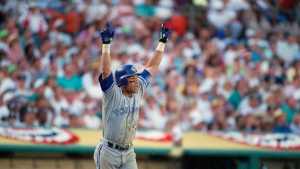 No matter the era, you rarely see trades of this magnitude go down, but when they do they are absolutely stunning.
No matter the era, you rarely see trades of this magnitude go down, but when they do they are absolutely stunning.
The baseball world stopped when this swap was announced, with four star players changing leagues, coasts and countries.
At the time, Fred McGriff was a star, coming off three straight seasons of 5.5-plus fWAR and he was just 26 years old.
Similarly, Tony Fernandez (RIP) was only 28 and providing elite defence at shortstop and posting 4.0-plus WAR seasons.
Seems like it would be hard to win that deal, right?
Well, getting a future Hall of Famer in return helps, and that’s exactly what Gillick did in prying away Alomar, who put up a pair of huge seasons in 1992 and ’93.
At the same time, Joe Carter proved to be a middle-of-the-order threat with an innate ability to provide key hits with runners on, hitting 30-plus homers and driving in 100-plus runs from 1991-’93.
But the real reason this trade appears here has little to do with the numbers and everything to do with the culture change and lineup mixture that resulted in back-to-back World Series titles.
In the grand scheme of things, it’s a very fair deal, but the bling it brought is what it’s all about.
2. Dale Murray and Tom Dodd to the New York Yankees for Fred McGriff, Dave Collins, Mike Morgan and cash, Dec. 9, 1982
The trade above might never happen if this one hadn’t gone down about six months after I was born.
With me in diapers, Gillick was busy stacking his early-career resume by pilfering the Crime Dog away from a division rival in exchange for a pair of assets, with the key piece being Dale Murray, a serviceable right-handed reliever who would finish with a 3.85 ERA over 12 seasons.
McGriff, meanwhile, showed up as a big-league regular in 1987 and immediately became one of the most consistent and productive left-handed bats in the game, starting his career with OPS’ of .881 (age-23), .928 (age-24), .924 (age-25), and .930 (age-26), before being paired up with Fernandez in the aforementioned blockbuster.
Across those five seasons in Toronto, McGriff ran up an elite 153 OPS+ and hit 125 home runs, going on to finish with 493 bombs in his 19-year career.
Despite falling off the Hall of Fame ballot last year, McGriff’s case for Cooperstown is strong with 56.9 fWAR and a career .284/.377/.509 slash line.
Here’s betting the Today’s Game committee takes another look at McGriff when they elect new HOFers in December 2021 for the 2022 Hall of Fame class or in December 2023 for the class of 2024.
1. Robinzon Diaz to the Pittsburgh Pirates for Jose Bautista, Aug. 21, 2008
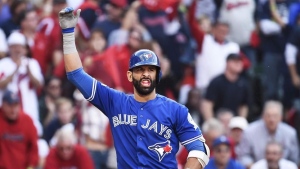 It doesn’t get any better than this, even if absolutely nobody saw it turning out this way at the time.
It doesn’t get any better than this, even if absolutely nobody saw it turning out this way at the time.
After bouncing around four different franchises to start his career, Bautista landed with his fifth in a completely-off-the-radar waiver deal in exchange for Diaz, a catcher who would appear in just 44 major-league games.
With assistant GMs Tony LaCava and Anthopoulos originally bringing the idea of the waiver claim to J.P. Ricciardi, the GM was on board and they found a way to strike a deal with the Pirates, giving the Jays some extra bench depth and a suitable injury replacement for third baseman Scott Rolen.
Bautista went on to bat .214 with three homers in 21 games after being acquired. Meh.
The following year, it was about the same, as Bautista limped to a .235/.349/.408 slash line, showing occasional glimpses of pop and an ability to take a walk and get on base.
From there, the rest is history.
Bautista shockingly put it all together in 2010 to hit 54 homers with a .995 OPS, before posting a monster .302/.447/.608 slash line in 2011 to become one of the premier power hitters in the game.
Bautista’s resume is hefty.
Not only did he hit 288 homers in a Jays uniform, the Santo Domingo, D.R., native helped bring postseason baseball back to Toronto, authoring one of the most dramatic moments in club history in the process.
He’s likely the next name to go up on the Level of Excellence, and they got him for free.
The Worst Trades
5. (TIE) Jeff Kent and Ryan Thompson to the New York Mets for David Cone, Aug. 27, 1992; John Olerud and cash to the Mets for Robert Person, Dec. 20, 1996
The old adage is you have to give up something to get something and that couldn’t be more true in the case of the David Cone trade.
Calling it one of the worst trades in franchise history may be a stretch for some, considering Cone was excellent down the stretch for the Jays in ’92 with a 2.55 ERA across seven starts and then had four reasonably solid outings in the postseason.
The issue, however, is that Gillick gave away a borderline Hall-of-Fame bat in Jeff Kent.
Was 75.1 total innings of Cone worth the 56.0 fWAR and 377 homers Kent would hit over his 17 seasons?
The World Series banner that Cone helped hang will be there forever, but it’s still a tough one to swallow as Kent’s prime came at a time that the Jays surely could’ve used his potent bat in the middle of their lineup in the late ‘90s and early 2000s.
Another trade with the Mets four years later isn’t as debatable.
After three down years following the World Series in ’93, GM Gord Ash had a decision to make following the 1996 season.
With Carlos Delgado showing signs of developing into the superstar everyone expected that year in his first full big-league season and 36-year-old outfielder Joe Carter needing more DH time as his career wound down, first baseman John Olerud was deemed expendable.
Trading Olerud heading into his age-28 season in ’97 proved to be a giant mistake.
Olerud went on to post a minimum of 4.4 fWAR per season in five of the next six years — his down year was still 3.6 fWAR — and even hit .354 with a gaudy .998 OPS in ’98.
Making matters worse, all Ash got in return was 27-year-old right-handed starter Robert Person, who proceeded to pitch to an ugly 6.18 ERA for the Jays over the next two seasons and change.
4. Noah Syndergaard, Travis d’Arnaud and Wuilmer Becerra to the Mets for R.A. Dickey, Josh Thole and Mike Nickeas, Dec. 17, 2012
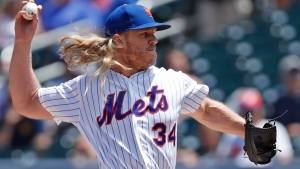 Another Mets giveaway, this trade has the potential to move up this list quickly once Thor’s career gets back underway after a Tommy John pause this year.
Another Mets giveaway, this trade has the potential to move up this list quickly once Thor’s career gets back underway after a Tommy John pause this year.
Honestly, every trade on this list was given consideration for the top spot, but there’s a few ways to look at this deal.
Sure, R.A. Dickey was the reigning NL Cy Young winner and the 2.73 ERA and 4.7 fWAR he posted in 2012 meant you had to pay a price to get him.
But it was pretty evident at the time, even to fairly casual observers, that regression may be in the knuckleballer’s future and the small AL East ballparks could be a problem. That’s exactly what happened.
Dickey wasn’t a total zero, producing exactly 1.8 fWAR in each of the next three seasons and an overall 4.05 ERA in his four seasons in Toronto, but Noah Syndergaard is a special, top-of-the-rotation force who has already accumulated 18.8 fWAR and a 3.31 ERA in his first 118 starts.
He’s still just 27.
At the same time, it took d’Arnaud a while to find his footing due to injuries, but the 31-year-old has been serviceable and he just signed a two-year, $16-million deal with the Braves and Anthopoulos, the man who made this trade.
3. David Wells and Matt DeWitt to the Chicago White Sox for Mike Sirotka, Mike Williams, Kevin Beirne and Brian Simmons, Jan. 14, 2001
Re-acquired in the Roger Clemens trade two years earlier, Wells was terrific for the Jays in 1999 and 2000, even if ERAs that start with a four aren’t exactly sexy.
What Wells did was eat innings — 461.2 over those two years — as well as limit walks, resulting in 20 wins and 6.2 fWAR in 2000.
His ERA was still 4.11 and he amazingly allowed a league-leading 266 hits over 229.2 innings that year, but it was good enough to make the all-star team, finish third in Cy Young voting, and somehow garner MVP votes, as well.
Just like with Clemens, Ash was handcuffed by a well-known trade request, but even amidst difficult circumstances the trade was an absolute train wreck.
Even though Wells wasn’t good with the Pale Hose in 2001 — he rebounded with the Yankees in 2002 — the Jays traded for a broken asset in Sirotka, who showed up in Toronto with a bum shoulder after winning 15 games with a 3.79 ERA in 2000 at the age of 29.
The Jays tried to get the deal rescinded, but that didn’t work, and the lefty never threw another pitch in the big leagues.
Ash was fired less than nine months later.
There are parallels here with the 2018 Donaldson deal, a trade that would also make this list if it went a touch deeper.
You simply can’t let great assets — at the time Wells was a great asset coming off a 20-win season — get away for absolutely nothing.
2. Roy Halladay and to the Philadelphia Phillies for Kyle Drabek, Travis d’Arnaud and Michael Taylor, Dec. 16, 2009
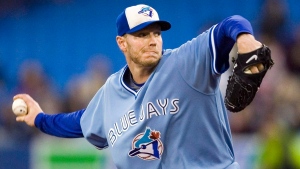 When you’re trading maybe the best pitcher you’ve ever drafted and developed, one on a Hall-of-Fame trajectory, you’re already behind the eight-ball and you have to hold out for every last drop of value.
When you’re trading maybe the best pitcher you’ve ever drafted and developed, one on a Hall-of-Fame trajectory, you’re already behind the eight-ball and you have to hold out for every last drop of value.
Evaluating trades in hindsight is always cherry-picking, but that’s also why trades can’t be properly evaluated at the time, because you just never know.
Only on the job for a few weeks at the time, Anthopoulos had the unenviable task of trading away one of the most popular players in franchise history, and did pretty well in doing so ... or so it seemed at the time.
Kyle Drabek was one of the top pitching prospects in baseball and a bloodline player before bloodline players were cool in Toronto.
He ended up making just 30 career starts and had a 5.27 ERA with the Jays.
As mentioned earlier, d’Arnaud was eventually flipped to the Mets in the Dickey deal, while Anthopoulos turned right around on the same day and sent Michael Taylor to the Oakland A’s in exchange for first base prospect Brett Wallace.
Wallace was later dealt to the Houston Astros in July for outfield prospect Anthony Gose, who Anthopoulos eventually turned into second baseman Devon Travis.
Travis is now out of baseball, leaving the Jays with nothing to show for Halladay a decade later and very little production along the way.
1. Michael Young and Darwin Cubillan to the Texas Rangers for Esteban Loaiza, July 19, 2000
A couple games back of the Yankees in the AL East race as the trade deadline approached, Ash engineered a deal with the Rangers in an effort to add some depth to the rotation.
At the time, Esteban Loaiza was holding down a 5.37 ERA in Texas, but he pitched better in Toronto, going 5-7 with a 3.62 ERA across 14 starts down the stretch.
The Jays still finished 4.5 games out.
Loaiza would go on to post a mediocre 4.96 ERA and make 69 starts in a Jays uniform, but dealing away Young ended up being a huge mistake.
A fifth-round pick of the Jays in 1997 out of the University of California, Young wasn’t exactly tearing up Double-A at the time with a sub-.800 OPS, and sort of like Kent eight years earlier, there didn’t seem to be a clear path to playing time.
Once again, the Jays picked the wrong guy to trade away.
From there, all Young did was go on to make seven all-star games in Texas and slash .300/.346/.441 over 14 big-league seasons.
Loaiza’s claim to fame?
He was caught with 44 pounds of cocaine in San Diego in 2018 and is currently serving a three-year prison sentence.


